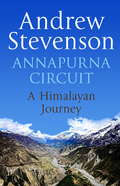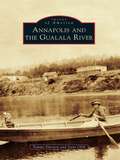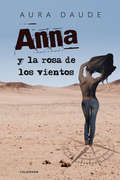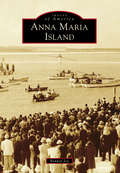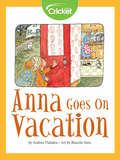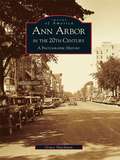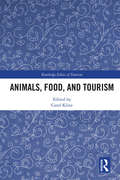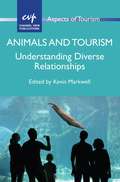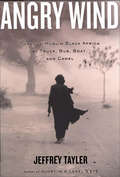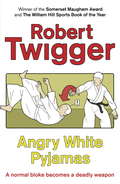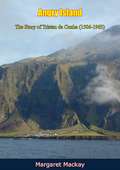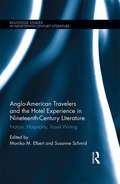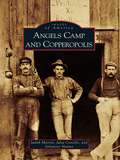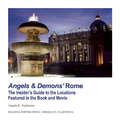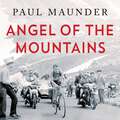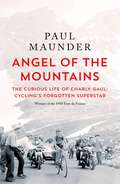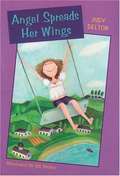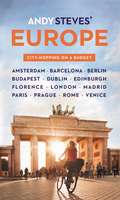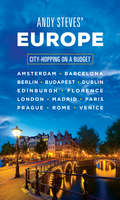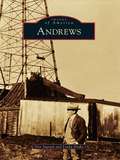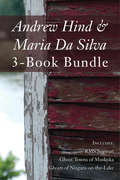- Table View
- List View
Annapurna Circuit: Himalayan Journey
by Andrew StevensonMany disenchanted Westerners have gone to the Himalayas in search of renewal, but no one has written about the experience as perceptively and personally as Andrew Stevenson in Annapurna Circuit.A traveller all his life, Stevenson responds to people and places with an openness unique to the cultural nomad - his portraits of the men, women and children of the Annapurnas, and the fellow-backpackers from all over the world who intermittently shared his journey, are a delight; his descriptions of the landscape, and the physical hardships of the trek are enthralling. But like every travel book of real quality, this is also the result of a spiritual journey. A richly rewarding read on every level, Annapurna Circuit is a modern travel classic in the tradition of Peter Matthiesson's Snow Leopard and Andrew Harvey's Journey to Ladakh.
Annapolis and the Gualala River (Images of America)
by Tammy Durston Steve OliffAnnapolis--a hidden jewel of a community--is tucked into the timber-filled ridges above the jagged northern Sonoma coastline. Undeterred by the steep, mountainous terrain and rugged living, early settlers were first lured to the area by the timber. They quickly discovered Annapolis had perfect weather for apple farming. At the beginning of the 20th century, almost every farm had apples, and apple dryers dotted the hills. The wild Gualala River, known for Coho salmon and steelhead trout, is 32 miles long and flows through the Annapolis area before meeting the Pacific Ocean. Early Native American Pomo tribes settled along this important river, which eventually served as a boundary between Sonoma and Mendocino Counties.
Anna y la rosa de los vientos
by Aura DaudeY todo parecía ser un típico viaje de turistas. Real, casi ficticia. Un solo día, un solo encuentro, la interacción entre dos desconocidos hará virar los acontecimientos. «Viaje a través de los meridianos», Historia del Arte, fotos prohibidas, expolio. No falto de ensayo, ¿podría asentarse una mina de oro en un conocido enclave arqueológico? Anna, un país y un final que te devuelven a medio relato.
Anna Maria Island (Images of America)
by Bonner JoyAnna Maria Island was once inhabited by Native Americans, but as the beauty became known to its first homesteader, George L. Bean, the island's destiny was to be a beacon to paradise. In spite of mangrove forests and throngs of mosquitoes, people came by boat to enjoy the white sand beaches and the turquoise waters of the Gulf of Mexico, with their cool onshore breezes and blazing sunsets. The Islander newspaper of the 1950s heralded, "Where life is good and the fishing is great." Anglers came from afar to test their skills against tarpon, the world's greatest game fish, and to hunt goliath grouper in the depths of Tampa Bay. Two modern bridges connected the island to the mainland in 1957, and with that the seven-mile-long island was on its way to becoming the jewel of Manatee County.
Anna Goes on Vacation
by Andrea VlahakisAnna packed her pajamas and slippers. Her toothbrush was in her backpack, too. And her favorite book. She is staying with her grandmother in the barn across the driveway. But that doesn't mean she still doesn't miss her father!
Ann Arbor in the 19th Century: A Photographic History
by Grace ShackmanAnn Arbor has never been a typical college town, typical industrial town, or typical agricultural center. The city was founded in 1824 by John Allen and Elisha Rumsey. Settlers from the Eastern U.S. of British origin were soon followed by Germans, who brought with them many practical skills. With the opening of the University of Michigan campus in 1841, still more people came from across the country to teach and learn. Ann Arbor in the 19th Century: A Photographic History, details the growth of the city, when residents built houses and businesses, organized a government, and established churches, schools, a university, and newspapers, in over 190 photographs. Early residents would recognize the photograph of Okemos, nephew of Pontiac, Chief of the Ottawa, who made regular visits to Ann Arbor, before the Native Americans were banished to Kansas by the federal government. Another fascinating photo shows Henry Otto's Band, whose family was responsible for much of the music at official events. However, much of 19th century Ann Arbor would still be recognizable to today's residents.
Animals, Food, and Tourism (Routledge Research in the Ethics of Tourism Series)
by Carol KlineFood is routinely given attention in tourism research as a motivator of travel. Regardless of whether tourists travel with a primary motivation for experiencing local food, eating is required during their trip. This book encompasses an interdisciplinary discussion of animals as a source of food within the context of tourism. Themes include the raising, harvesting, and processing of farm animals for food; considerations in marketing animals as food; and the link between consuming animals and current environmental concerns. Ethical issues are addressed in social, economic, environmental, and political terms. The chapters are grounded in ethics-related theories and frameworks including critical theory, ecofeminism, gustatory ethics, environmental ethics, ethics within a political economy context, cultural relativism, market construction paradigm, ethical resistance, and the Global Sustainable Tourism Criteria. Several chapters explore contradicting and paradoxical ethical perspectives, whether those contradictions exist between government and private sector, between tourism and other industries, or whether they lie within ourselves. Like the authors in Tourism Experiences & Animal Consumption: Contested Values, Morality, & Ethics, the authors in this book wrestle with a range of issues such as animal sentience, the environmental consequences of animals as food, viewing animals solely as a extractive resource for human will, as well as the artificial cultural distortion of animals as food for tourism marketing purposes. This book will appeal to tourism academics and graduate students as a reference for their own research or as supplementary material for courses focused on ethics within tourism.
Animals and Tourism
by Kevin MarkwellThis book critically examines the many ways in which tourism and animals intersect, whether as tourist attractions, wildlife conservation tools, as travel companions or as meat to be eaten. It aims to make a meaningful contribution to the growing body of knowledge concerning the relationships between animals, tourists and the tourism industry. The chapters are organised into three themes: ethics and welfare; conflict, contradiction and contestation; and shifting relationships. Theoretically informed and empirically rich, the chapters examine topics such as whale watching, animal performances, the objectification and commodification of animals and stakeholder conflict among a range of others. It is hoped that the book will help to highlight key research questions and stimulate other researchers and students to reflect critically on the place of animals within tourism spaces, experiences, practices and structures.
Angry Wind: Through Muslim Black Africa by Truck, Bus, Boat, and Camel
by Jeffrey TaylerTraveling by bus, airplane, in the back of trucks and on camel, the author travels through the most war-torn parts of Africa. The author answers such crucial questions as 'What do Muslims think of President Bush?' and 'Do all Muslims and Africans hate Americans?' Tayler travels through some of the most remote and war-torn parts of Africa to find out. From the corrupt dealings in Nigeria to the war-torn areas of Mali and Chad, the author shows us the beautiful humanity and heart-breaking inhumanity of man.
Angry Wind: Through Muslim Black Africa by Truck, Bus, Boat, and Camel
by Jeffrey TaylerHailed by Bill Bryson and the New York Times Book Review as a rising star among travel writers, Jeffrey Tayler penetrates one of the most isolated, forbidding regions on earth--the Sahel. This lower expanse of the Sahara, which marks the southern limit of Islam&’s reach in West and Central Africa, boasts such mythologized places as Mopti and Timbuktu, as well as Africa&’s poorest countries, Chad and Niger. In parts of the Sahel, hard-line Sharia law rules and slaves are still traded. Racked by lethal harmattan winds, chronic civil wars, and grim Islamic fundamentalism, it is not the ideal place for a traveler with a U.S. passport. Tayler finds genuine danger in many guises, from drunken soldiers to a thieving teenage mob. But he also encounters patience and generosity of a sort found only in Africa. Traveling overland by the same rickety means used by the local people--tottering, overfilled buses, bush taxis with holes in the floor, disgruntled camels--he uses his fluency in French and Arabic (the region&’s lingua francas) to connect with them. Tayler is able to illuminate the roiling, enigmatic cultures of the Sahel as no other Western writer could.
Angry White Pyjamas
by Robert TwiggerA brilliant and captivating insight into the bizarre nature of contemporary Japan.Adrift in Tokyo, teaching giggling Japanese highschool girls how to pronounce Tennyson correctly, Robert Twigger came to a revelation about himself: he'd never been fit. In a bid to escape the cockroach infestation and sweaty squalor of a cramped apartment in Fuji Heights, Twigger sets out to cleanse his body and his mind. Not knowing his fist from his elbow the author is sucked into the world of Japanese martial arts, and the brutally demanding course of budo training taken by the Tokyo Riot Police, where any ascetic motivation soon comes up against blood-stained dogis and fractured collarbones.In Angry White Pyjamas Robert Twigger skilfully blends the ancient with the modern - the ultra-traditionalism, ritual and violence of the dojo (training academy) with the shopping malls, nightclubs and scenes of everyday Tokyo life in the twenty-first century - to provide an entertaining and captivating glimpse of contemporary Japan.
Angry White Pyjamas
by Robert TwiggerA brilliant and captivating insight into the bizarre nature of contemporary Japan.Adrift in Tokyo, teaching giggling Japanese highschool girls how to pronounce Tennyson correctly, Robert Twigger came to a revelation about himself: he'd never been fit. In a bid to escape the cockroach infestation and sweaty squalor of a cramped apartment in Fuji Heights, Twigger sets out to cleanse his body and his mind. Not knowing his fist from his elbow the author is sucked into the world of Japanese martial arts, and the brutally demanding course of budo training taken by the Tokyo Riot Police, where any ascetic motivation soon comes up against blood-stained dogis and fractured collarbones.In Angry White Pyjamas Robert Twigger skilfully blends the ancient with the modern - the ultra-traditionalism, ritual and violence of the dojo (training academy) with the shopping malls, nightclubs and scenes of everyday Tokyo life in the twenty-first century - to provide an entertaining and captivating glimpse of contemporary Japan.
Angry Island: The Story of Tristan da Cunha (1506-1963)
by Margaret MackayTristan da Cunha is both a remote group of volcanic islands in the south Atlantic Ocean and the main island of that group. It is the most remote inhabited archipelago in the world, lying approximately 1,511 miles (2,432 km) off the coast of Cape Town in South Africa, 1,343 miles (2,161 km) from Saint Helena and 2,166 miles (3,486 km) off the coast from the Falkland Islands. The territory consists of the main island, Tristan da Cunha, which has a diameter of roughly 11 km (6.8 mi) and an area of 98 sq km (38 sq mi), the smaller, uninhabited Nightingale Islands, and the wildlife reserves of Inaccessible Island and Gough Island. As of October 2018, the main island has 250 permanent inhabitants who all carry British Overseas Territories citizenship. The other islands are uninhabited, except for the personnel of a weather station on Gough Island.Tristan da Cunha is part of the British Overseas Territory of Saint Helena, Ascension, and Tristan da Cunha. This includes Saint Helena and also near-equatorial Ascension Island, which lies some 1,741 miles (2,802 km) to the north of Tristan. There is no airstrip of any kind on the main island, meaning that the only way of travelling in and out of Tristan is by boat, a six-day trip from South Africa.Angry Island: The Story of Tristan da Cunha (1506-1963) by Margaret Mackay was first published in 1963, the year the Tristanians returned to their island after its volcano erupted in 1961 and forced the evacuation of the entire population to England. As the most isolated inhabited island on Earth, the Tristanians have had to adapt and develop innovative ways in order to survive, and in this book, Mrs. Mackay tells a very detailed history of Tristan da Cunha since its discovery over five hundred years ago, sharing many shipwreck tales and early yet failed attempts to settle the island.A gripping read!
Anglo-American Travelers and the Hotel Experience in Nineteenth-Century Literature: Nation, Hospitality, Travel Writing (Routledge Studies in Nineteenth Century Literature)
by Susanne Schmid Monika M ElbertThis volume examines the hotel experience of Anglo-American travelers in the nineteenth century from the viewpoint of literary and cultural studies as well as spatiality theory. Focusing on the social and imaginary space of the hotel in fiction, periodicals, diaries, and travel accounts, the essays shed new light on nineteenth-century notions of travel writing. Analyzing the liminal space of the hotel affords a new way of understanding the freedoms and restrictions felt by travelers from different social classes and nations. As an environment that forced travelers to reimagine themselves or their cultural backgrounds, the hotel could provide exhilarating moments of self-discovery or dangerous feelings of alienation. It could prove liberating to the tourist seeking an escape from prescribed gender roles or social class constructs. The book addresses changing notions of nationality, social class, and gender in a variety of expansive or oppressive hotel milieu: in the private space of the hotel room and in the public spaces (foyers, parlors, dining areas). Sections address topics including nationalism and imperialism; the mundane vs. the supernatural; comfort and capitalist excess; assignations, trysts, and memorable encounters in hotels; and women’s travels. The book also offers a brief history of inns and hotels of the time period, emphasizing how hotels play a large role in literary texts, where they frequently reflect order and disorder in a personal and/or national context. This collection will appeal to scholars in literature, travel writing, history, cultural studies, and transnational studies, and to those with interest in travel and tourism, hospitality, and domesticity.
Angels Camp and Copperopolis
by Sal Manna Judith Marvin Julia CostelloThe Angels Camp and Copperopolis regions offer a fascinating chapter in the history of the Mother Lode. Calaveras County's southwest corner has many tales to tell, including one of the earliest settlements of the Native American in California; two of the most famous names in Americana, Mark Twain and Black Bart; and two major events in national history, the Gold Rush and the Civil War. An important Gold Rush town, Angels Camp gained even greater fame through Twain's "The Celebrated Jumping Frog of Calaveras County," which inspired the world-famous Jumping Frog Jubilee. At the same time, Copperopolis became a critical supplier of copper to the Union during the Civil War. Legendary outlaw Black Bart made his first and his last stagecoach holdup here. Ferries and railways served the region that also included the settlements of Hodson, Milton, Felix, Carson Hill, Dogtown, and Lost City.
Angels & Demons Rome
by Angela K. NickersonRetrace the steps of Robert Langdon, Vittoria Vetra, the Hassassin, and the camerlengo, to find a new and exciting perspective on the city of Rome.
Angel of the Mountains: The Strange Tale of Charly Gaul, Winner of the 1958 Tour de France
by Paul Maunder'Maunder's book is more than just a biography of the rise and fall of a complicated man . . . It is also a critique of the damage that myth-making and the media can do to an athlete; a study of what happens to a demigod when thrown from Mount Olympus' The TimesCharly Gaul is a forgotten cycling legend. Once a household name across Europe, the diminutive Luxembourger won the 1958 Tour de France and the Giro d'Italia twice. A unique rider, Gaul was supremely gifted at climbing and resilient even in the foulest weather. His pedalling style was smooth and swift, and he could set an unmatchable metronome rhythm on a mountain climb. 'Mozart on two wheels,' was how one contemporary writer described him; another dubbed him 'The Angel of the Mountains'.At the end of his cycling career Gaul disappeared, becoming a hermit living in a forest in Luxembourg. What drove Charly Gaul into a recluse's life? In Angel of the Mountains, Paul Maunder seeks to uncover the truth about Gaul, his psychology and the circumstances of his withdrawal from society. In rediscovering Gaul's enigmatic life, we find not only an unlikely hero but also a larger truth about the nature of sporting success.
Angel of the Mountains: The Strange Tale of Charly Gaul, Winner of the 1958 Tour de France
by Paul Maunder'Maunder's book is more than just a biography of the rise and fall of a complicated man . . . It is also a critique of the damage that myth-making and the media can do to an athlete; a study of what happens to a demigod when thrown from Mount Olympus' The TimesCharly Gaul is a forgotten cycling legend. Once a household name across Europe, the diminutive Luxembourger won the 1958 Tour de France and the Giro d'Italia twice. A unique rider, Gaul was supremely gifted at climbing and resilient even in the foulest weather. His pedalling style was smooth and swift, and he could set an unmatchable metronome rhythm on a mountain climb. 'Mozart on two wheels,' was how one contemporary writer described him; another dubbed him 'The Angel of the Mountains'.At the end of his cycling career Gaul disappeared, becoming a hermit living in a forest in Luxembourg. What drove Charly Gaul into a recluse's life? In Angel of the Mountains, Paul Maunder seeks to uncover the truth about Gaul, his psychology and the circumstances of his withdrawal from society. In rediscovering Gaul's enigmatic life, we find not only an unlikely hero but also a larger truth about the nature of sporting success.
Angel of the Mountains: The Strange Tale of Charly Gaul, Winner of the 1958 Tour de France
by Paul Maunder'Maunder's book is more than just a biography of the rise and fall of a complicated man . . . It is also a critique of the damage that myth-making and the media can do to an athlete; a study of what happens to a demigod when thrown from Mount Olympus' The TimesCharly Gaul is a forgotten cycling legend. Once a household name across Europe, the diminutive Luxembourger won the 1958 Tour de France and the Giro d'Italia twice. A unique rider, Gaul was supremely gifted at climbing and resilient even in the foulest weather. His pedalling style was smooth and swift, and he could set an unmatchable metronome rhythm on a mountain climb. 'Mozart on two wheels,' was how one contemporary writer described him; another dubbed him 'The Angel of the Mountains'.At the end of his cycling career Gaul disappeared, becoming a hermit living in a forest in Luxembourg. What drove Charly Gaul into a recluse's life? In Angel of the Mountains, Paul Maunder seeks to uncover the truth about Gaul, his psychology and the circumstances of his withdrawal from society. In rediscovering Gaul's enigmatic life, we find not only an unlikely hero but also a larger truth about the nature of sporting success.
Angel Spreads Her Wings (Angel O'Leary #6)
by Judy Delton Jill WeberWith the excitement of her mother getting married and having a baby, Angel is ready for a nice long summer at home in Elm City, Wisconsin. But another change is brewing for poor Angel. Her stepfather is taking the family to Greece to meet their new grandparents. Angel will have to get on a plane and fly over the ocean to a foreign land - will she have to use one of those airsick bags on the plane? Will there be anything to eat in Greece besides those little fish with their heads on? How will she understand her grandparents? And, most important, will Angel ever make it back home or will her stepfather want the family to stay in Greece forever? Back by popular demand, here is another fast-paced, hilarious adventure for that much-loved character, Angel. Change isn't always easy, but even worrywart Angel just may spread her wings a little as she learns that home is where the heart is. Bookshare holds the key to all of the books about angel, the little girl who worries too much. Read about her adventures in: Back Yard Angel, Angel in Charge, Angel's Mother's Boyfriend, Angel's Mother's Wedding and Angel's Mother's Baby.
Andy Steves' Europe: City-Hopping on a Budget (Andy Steves)
by Andy StevesPick a Weekend, Pick a City, and Go! Andy Steves' travel guide picks up where crowdsourcing leaves off, covering the skills you need for spur-of-the-moment trips to Europe's top destinations. Follow strategic, three-day itineraries for exploring each city. Learn which cities match your interests and which can be easily combined for a longer trip, including itineraries for Amsterdam, Barcelona, Berlin, Budapest, Dublin, Edinburgh, Florence, London, Madrid, Paris, Prague, Rome, and Venice. See iconic sights. Check the Eiffel Tower, the London Eye, and the Colosseum off your bucket list, and use Andy's tips to save time and skip lines. Hit the local hot spots. Chill at Amsterdam's coffee shops, study mixology at London's speakeasies, and bust moves at Barcelona's beach clubs. Enjoy the best (and cheapest) local cuisine. Graze at boulangeries in Paris, pubs in Dublin, and aperitivo bars in Rome. Become a temporary local. Engage with the culture to enjoy authentic, unforgettable experiences. Master digital travel. Make the most of your money in Europe with apps and other digital resources. Connect with other travelers. Head to the most popular hostels for a ready-made, real-life social network.Enjoy handy tools at your fingertips, with full-color photos and detailed, helpful maps throughout. Whether you're studying abroad or just looking to explore Europe without breaking the bank, Andy Steves' Europe will have you city-hopping like a pro.
Andy Steves' Europe: City-Hopping on a Budget
by Andy StevesPick a Weekend, Pick a City, and Go!This book picks up where crowdsourcing leaves off, covering the flashpacker skills you need for spur-of-the-moment trips to Europe's top destinations.Follow three-day plans to explore each city. Learn which cities match your interests and which can be easily combined for a longer trip, including itineraries for Amsterdam, Barcelona, Berlin, Budapest, Dublin, Edinburgh, Florence, London, Madrid, Paris, Prague, Rome, and Venice.See iconic sights. Check the Eiffel Tower, the London Eye, and the Colosseum off your bucket list-and use Andy's tips to save time and skip lines.Hit the local hot spots. Chill at Amsterdam's coffee shops, study mixology at London's speakeasies, and bust moves at Barcelona's beach clubs.Enjoy the best-and cheapest-local cuisine. Graze at crêperies in Paris, pubs in Dublin, and aperitivo in Rome.Become a temporary local. Adapt to the culture to enjoy authentic, unforgettable experiences.Master digital travel. Discover how tools like AirBnB and Uber can help you make the most of your money in Europe.Connect with other travelers. Head to the most popular hostels for a ready-made, real-life social network.Whether you're looking to study abroad or just explore Europe without breaking the bank, Andy Steves Europe is the guide for you.
Andrews (Images of America)
by Linda Drake Don IngramAndrews County was named for Richard Andrews, the first casualty in Texas's fight for independence from Mexico in 1835 at the battle of Concepción. Before the creation of the county in 1876 by the Texas legislature, the area had been largely ignored by state officials and avoided by ranchers and settlers because of its remoteness, scarcity of water, and attacks by local Native Americans. That all changed in 1875 after an expedition by U.S. cavalry troops led by Col. William R. Shafter opened the region up to settlers. The town of Andrews became the county seat in 1910 after a close election race with nearby Shafter Lake. Ranching was the first economic driver in the county, but the discovery of oil in 1929 changed everything. The oil boom created jobs, brought in revenue, and attracted new residents. Today Andrews is experiencing growth thanks to renewed demand for oil, nuclear-related industries, first-class sporting venues, and other amenities that have rejuvenated the community.
Andrew Zimmern's Bizarre World of Food: Brains, Bugs, and Blood Sausage
by Andrew ZimmernHave you ever thought about eating giant flying ants? Or raw camel kidneys? Well, read on to watch Andrew Zimmern not only eat these unique and gross foods, but live to tell the tale about the people, places, and adventures he's had while roaming the world in search of new and exciting meals. Zimmern takes readers from country to country, visiting local markets, participating in cultural feasts, and chasing down native wildlife to taste what each country has to offer, and discovering what is most authentic about each place he visits and the amazing information he receives while traveling to these countries. And you can too! Come along on Andrew's amazing adventures and learn fun facts about the animals he encounters, the people he meets, and the places he explores. You'll also find cool recipes to try at home. So let Andrew Zimmern be your guide as he takes you around the world, eating his way through foods one couldn't even dream of eating, while celebrating the undiscovered destinations and weird wonders still taking place today.From the Hardcover edition.
Andrew Hind and Maria Da Silva 3-Book Bundle: RMS Segwun / Ghost Towns of Muskoka / Ghosts of Niagara-on-the-Lake
by Andrew Hind Maria Da SilvaThree titles in Andrew Hind and Maria Da Silva’s acclaimed series on the local history, maritime colour, and even the shadowy side of Ontario’s most picturesque communities. From ghost towns to actual ghosts, the unexpected abounds in this collection of the most surprising corners of Ontario — a must for cottagers and local-history lovers, brought to you by two of the best! Includes: RMS Segwun Ghost Towns of Muskoka Ghosts of Niagara-on-the-Lake
